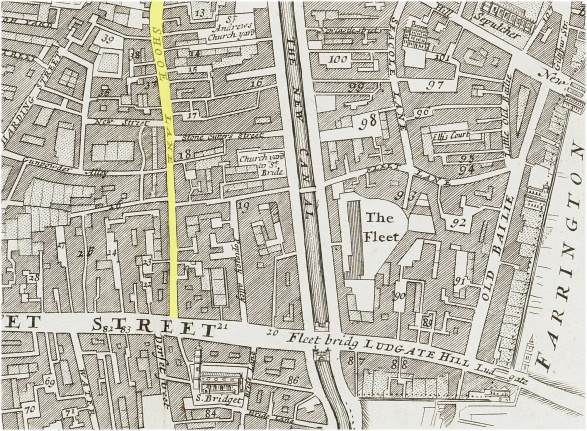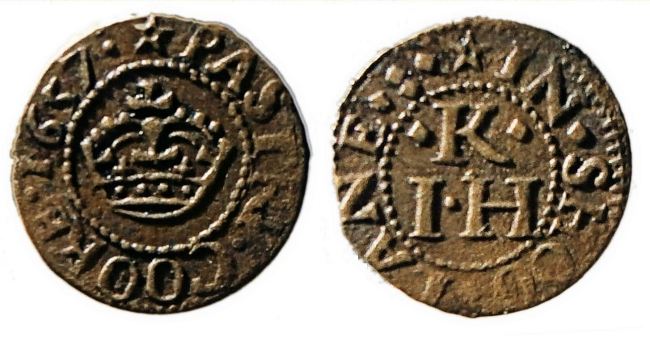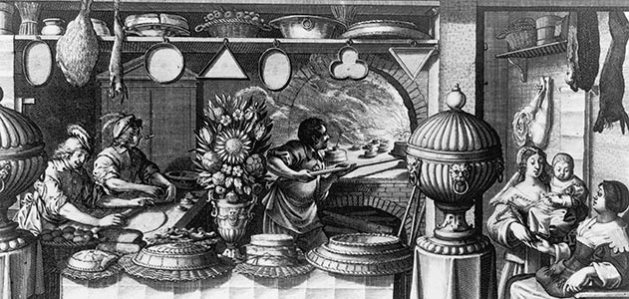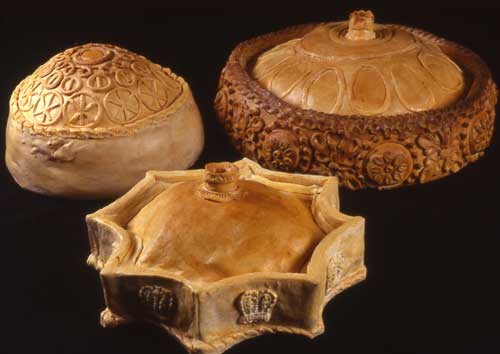The copper farthing token, pictured above, measures 15.3 mm and weighs 0.95 grams. It was issued in 1657 by a pastry cook operating from premises at or by the sign of the Crown in Shoe Lane off the north side of Fleet Street, London. Such tradesmen’s tokens normally had only a limited geographical area of circulation. Typically this may have been restricted to the immediate urban district in which their issuers lived and were known. However, some tokens inevitably travelled much further afield. Once captured amongst the small change in an individual’s pocket or purse they could have travelled great distances from their point of origin before ultimately being forgotten about and ultimately lost or discarded. This appears to have been the fate of the above example which was discovered approximately 350 years after its issue date on the River Thames foreshore at Gravesend in Kent.
The design of the token may be formally described as follows;
Obverse: (pierced mullet) PASTRY. COOKE. 1657., around a twisted wire circle. Within the depiction of a stylised crown of four arches studded with pearls and a jewelled headband with alternating decorations of crosses paté and fleurs-de-lis
Reverse: (pierced mullet) IN. SHOO. LANE -:-, around a twisted wire circle, within a triad of initials comprising I | .K. | .H
This is one of 21 different tokens issued by a variety of private tradesmen who lived and worked in Shoe Lane during the period 1649 to 1672. In the mid-17th century Shoe Lane linked Fleet Street and Holborn Hill. St. Bride’s (or St. Bridget’s) parish church served those in the lane who lived in the southern end against Fleet Street.
The initials, in capitalised Latin letters, on the reverse of the above token are those of the issuer and his wife, i.e. Mr. “J/I.K.” and his wife Mrs. “H.K.”
It is clear from the above token image, along with those of other surviving examples, that the surname of the token issuer began with a “K”. However, it is understandable how poorer quality survivals of this token lead one earlier researcher to read this initial as an “R”. The combined initials of the token’s primary issuer could then be interpreted as “J.R.” which would fit perfectly with those of a potential issuer of the tokens who is mentioned in a contemporary survey of building sites in London a couple of years after the Great Fire of September 1666 (1) ;
“Mr. John Reynolds May the 24th 1669
One foundation set out the day above said near Fleet Street formally the Sign of the Crown in Shoe Lane belonging to the said Mr. Reynolds…”
It is understandable how such a mistake could have been made but when faced with good condition examples of the above token there is no escaping that the actual surname initial on it is a “K” and not an “R”. However, the above reference does contain some useful historical information in that;
-
At the time of the Great Fire of London in early September 1666 a John Reynolds is credited with owing the building plot on which the sign of the Crown in Shoe Lane stood.
-
The building identified by the sign of the Crown in Shoe Lane was located at the Fleet Street end of lane (i.e. the southern end).
A review of Hearth Tax returns for Shoe Lane in 1666 (just prior to the Great Fire) indicates that in the St. Bride’s (Fleet Street) Precinct of Shoe Lane a John Reygnolds [sic] paid tax on premises with 10 hearths. This is the second largest hearth count for any building in the lane. The above mentioned person is almost certainly the same John Reynolds who rebuilt the Crown in 1669. The relatively large number of hearths recorded for the premises in 1666 suggests, together with its trade sign (i.e. the Crown), that it was a good sized tavern.

A map showing part of the parish of St. Bride’s Fleet Street (c.1720) indicating the southern end of Shoe Lane
A further review of the 1666 Hearth Tax returns for Shoe Lane indicates that within a few buildings to the south of John Reynolds at the Crown was a property with an even higher hearth count of 14. More interestingly is the name of the man that is listed against this entry, John Knowles. It is possible that this man is the issuer of the above farthing trade token. The initial evidence for this can be drawn directly from his Hearth Tax return entry in that;
-
He operated from a building located close to the sign of the Crown (as indicated on the token).
-
He operated from a building containing 14 hearths (the highest count for any building in Shoe Lane). Such a high hearth/oven count would not be untypical for a pastry cook (i.e. the stated trade of the token issuer).
-
His initials fit exactly with those of the token issuer (i.e. “J.K.”).
Further research has uncovered additional facts concerning John Knowles that almost certainly confirms him as the issuer of the above token. A review of contemporary London parish registers has confirmed that there was a family by the name of Knowles living in the parish of St. Bride’s, Fleet Street from at least the mid-1620s and that by the mid-1660s John and Hannah Knowles, together with their children, were almost certainly living in Shoe Lane.
The first reference to John and Hannah Knowles by name in the parish records occurs in 1647. This entry records the first of several of their children’s baptisms. These include;
-
Elizabeth – 27th July 1647
-
John Knowles – 29th June 1648
-
Charles Knowles – 6th August 1649
-
Mary Knowles – 9th December 1650
-
Hannah Knowles – 21st February 1651/2
-
Samuel Knowles – 10th September 1654
Whilst it is unclear if John Knowles had always been a pastry cook it was certainly his stated trade in 1657 when he issued his token. Approximately 19 London cooks issued trade tokens during the period 1649 to 1672. However, only three of these are known to have been specifically pastry cooks.
As a pastry cook who presumably also sold his wares directly to the public from his Shoe Lane premises it is likely that all of the Knowles family would have assisted in some way in John’s busy work. His business was sufficiently large to warrant him taking on apprentices at various points in time. The following individuals are recorded in the post 1654 apprenticeship registers of the Worshipful Company of Cooks as being bound into service to John Knowles (2);
-
Richard Woodroffe – 2 March 1654/5
-
Michael Lucas – 28th January 1658/9
-
Edward Jarvis – 9th June 1662
-
Richard Michell – 9th July 1661
Apprentices would normally be bound to a master for a period of 7 years from the age of 14. Assuming they served their time they became eligible to apply for membership/freedom of their appropriate Livery Company.
A review of contemporary records has failed to highlight any further information about the later history of either John or Hannah Knowles. There are however two burial records in the registers of St. Bride’s, Fleet Street that may relate to that of John Knowles the token issuer. Unfortunately with our token issuer having a son of the same name it is difficult to differentiate between their deaths from a simple parish register entry without any reference to a spouse’s or parent’s name. Neither of the two burial register entries offer either such clues;
8th October 1665 – John Knoles from Shoo lane
31st January 1698/9 – John Knowles at Leues up ye steps popinge ally
However, given the earlier Hearth Tax evidence we know that a John Knowles was still head of the Shoe Lane household in 1666. If it had been John Knowles senior who had died the previous year it would be expected that the head of the household would have reverted to his widow Hannah, assuming she was still alive. At the relatively young age of 17 it is questionable if John Knowles junior could have legally qualified to become head of the household, even if his mother had previously died. Assuming John Knowles senior had sufficient funds it would be normal to expect him to have paid to put his sons into suitable apprenticeships or to have attained their freedom within his own Livery Company by means of “patrimony”.
Assuming that the above parish register entries relate to our token issuer and his son, and not coincidentally named individuals, the combined evidence points to the first burial record (i.e. in 1665) being that for the 17 year old John Knowles junior. The second (i.e. in 1698/9) is then likely to be that for John Knowles senior who must have returned to the Shoe Lane area after the Great Fire of September 1666 to re-establish his business.
Based on the above deduction it appears highly possible that John Knowles junior died while still working for the family business in Shoe Lane. The date of his death is significant as it coincides with a period in 1665 when London was being ravaged by one of the most infamous outbreaks of bubonic plague. Between the start of the outbreak in early 1665 and its eventual disappearance in early 1666 the plague is estimated to have claimed the lives of approximately 100,000 citizens. The death toll reached a peak during the warm Summer months but even into early October 1665 was still claiming between 2,000 to 4,000 victims per week. On the 8th October, the day of John Knowles junior’s internment; his body was one of 10 that were buried in the churchyard of St. Bride’s Fleet Street alone, the following day saw a further 16 burials at St. Bride’s and the day afterwards another 15.
The presumed burial register entry for John Knowles senior (i.e. 31st January 1698/9) indicates him living at “Leues” (an unknown personal or business premises name) up the steps in Popinjay Ally. This ally or court ran to the east and parallel to Shoe Lane. In August 1663 the famous diarist Samuel Pepys records entering this alley via a gate way off the north side of Fleet Street and visiting an alehouse there (3). This may have been the Green Dragon which is recorded as having issued its own farthing trade tokens during the mid-1650s to early 1660s (4). In addition to this alehouse it is likely that the ally contained a mixture of private homes and businesses. It is possible that “Leues” was one such business, possibly a cook house (i.e. a type of hot food take away establishment popular in mid-17th London) where in his later years John Knowles may have been living and working in semi-retirement.
References:
-
Mills, P. & Oliver, J. – The Survey of Building Sites in the City of London after the Great Fire of 1666. Volume II. (London Topographical Society Publication. No.103. 1967).
-
Webb, C. – London Livery Company Apprenticeship Registers, Cooks’ Company 1654-1800. Volume 26. (Society of Genealogists. 1999).
-
Latham, R.C. – The Diary of Samuel Pepys: Volume IV – 1663 (Harper Collins, 2010).





A fascinating bit of detective work! I love how you are able to recreate the world of the 1660s from just a few scraps! Thanks for sharing!
LikeLike
Pingback: Страсбургский пирог (А. С. Пушкин. «Евгений Онегин») | Еда в литературе